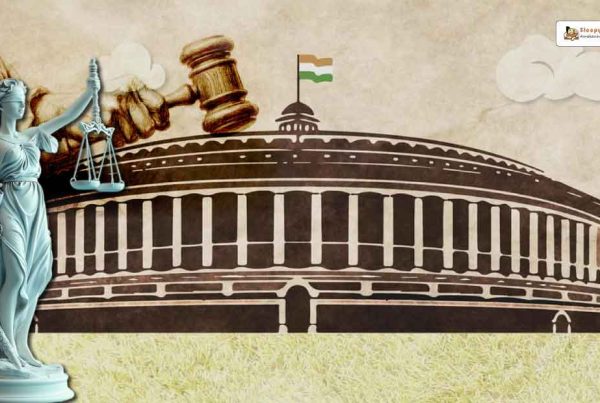The 42nd Amendment, often called the “Mini-Constitution,” was a major change to the Indian Constitution made in 1976. It aimed to shift the balance of power more towards the central government and away from the states. This amendment brought about many changes, affecting everything from the Preamble to the powers of the judiciary.
Key Takeaways
- The 42nd Amendment was introduced in 1976 during Indira Gandhi’s Emergency period.
- It added the words ‘Socialist,’ ‘Secular,’ and ‘Integrity’ to the Preamble of the Indian Constitution.
- The amendment expanded the list of Fundamental Duties for Indian citizens.
- It significantly reduced the power of the judiciary, especially the Supreme Court and High Courts.
- The changes made by the 42nd Amendment were partially reversed by the 43rd and 44th Amendments.
Historical Context and Background
Political Climate Leading to the Amendment
In the early 1970s, India was going through a period of significant political and social turmoil. The country faced economic challenges, social unrest, and political instability. Prime Minister Indira Gandhi’s government was under immense pressure due to rising inflation, unemployment, and widespread protests. The political climate was charged, and the government sought ways to consolidate its power and address the growing discontent among the populace.
Role of the Swaran Singh Committee
To address the need for constitutional changes, the government formed the Swaran Singh Committee in 1976. The committee was tasked with reviewing the Constitution and suggesting amendments to strengthen the central government’s authority. The committee’s recommendations played a crucial role in shaping the 42nd Amendment, which aimed to bring about significant changes in the Indian Constitution.
Objectives Behind the Amendment
The primary objective of the 42nd Amendment was to enhance the power of the central government and reduce the influence of the judiciary. The amendment sought to make the Constitution more flexible and responsive to the needs of the time. It aimed to address issues related to governance, social justice, and economic development. The amendment also introduced new Directive Principles of State Policy, emphasizing equal justice and free legal aid, among other goals.
Key Changes Introduced by the 42nd Amendment
Alterations to the Preamble
The 42nd Amendment made significant changes to the Preamble of the Indian Constitution. It added the words “Socialist,” “Secular,” and “Integrity” to the Preamble. This change aimed to reflect the government’s commitment to a more inclusive and equitable society. These additions emphasized the importance of social justice and national unity.
Expansion of Fundamental Duties
One of the major changes brought by the 42nd Amendment was the inclusion of Fundamental Duties for citizens. These duties were added to remind citizens of their responsibilities towards the nation. The amendment listed ten duties, including respecting the Constitution, promoting harmony, and protecting the environment. This was a move to encourage a sense of duty and patriotism among the people.
Impact on the Judiciary
The 42nd Amendment also had a profound impact on the judiciary. It curtailed the power of the courts to review and invalidate laws passed by the Parliament. This was done by amending Articles 32, 131, and 226, which limited the judiciary’s role in checking the constitutionality of laws. The amendment aimed to reduce judicial interference in legislative matters, thereby strengthening the Parliament’s authority.
The 42nd Amendment Act of 1976 is often referred to as a “mini-Constitution” due to the extensive changes it brought to the Indian Constitution. It was a turning point in the constitutional history of India, marking a shift towards a more centralized form of governance.
Impact on the Federal Structure
The 42nd Amendment had a profound impact on India’s federal structure. It significantly increased the power of the central government, reducing the autonomy of state governments. This shift emphasized a more unitary system, which some argued was against the federal nature of the nation.
Strengthening of Central Government Powers
The amendment transferred several key powers from the states to the central government. This centralization aimed to create a more uniform policy across the country but was seen by many as an overreach of central authority.
Changes in Center-State Relations
The balance of power between the center and the states was altered. States found themselves with less control over their own affairs, leading to tensions and conflicts over jurisdiction and governance.
Implications for Regional Parties
Regional parties, which often championed state rights and local issues, found their influence diminished. The centralization of power made it harder for these parties to advocate for their regions effectively.
The 42nd Amendment’s impact on the federal structure remains a topic of ongoing debate, with many questioning whether it strengthened or weakened the overall governance of India.
Controversies and Criticisms
Opposition from Political Parties
The 42nd Amendment faced strong opposition from various political parties. Many argued that the changes were an attempt to centralize power and undermine democratic principles. Critics believed that the amendment was a way for the ruling party to tighten its grip on the country.
Legal Challenges and Judicial Review
The amendment led to numerous legal challenges. The judiciary was tasked with reviewing the constitutionality of the changes. This period saw a significant number of court cases questioning the validity of the amendment. The Supreme Court played a crucial role in examining these issues.
Public Perception and Protests
Public reaction to the 42nd Amendment was mixed. While some supported the changes, many others took to the streets in protest. The amendment was seen by many as a threat to the democratic fabric of the nation. Protests erupted across the country, reflecting widespread discontent.
The 42nd Amendment, often referred to as the “mini constitution,” remains one of the most debated changes in India’s constitutional history.
Subsequent Amendments and Revisions
The 43rd and 44th Amendments
After the 42nd Amendment, the Indian Constitution saw significant changes through the 43rd and 44th Amendments. These amendments aimed to undo some of the controversial changes made by the 42nd Amendment. The 44th Amendment, in particular, was crucial as it restored the balance of power between the judiciary and the government.
Reversal of Key Provisions
The 43rd and 44th Amendments reversed several provisions of the 42nd Amendment. For instance, the power of judicial review, which had been curtailed, was reinstated. This ensured that the Supreme Court and High Courts could once again check the actions of the government.
Long-term Effects on Indian Democracy
The changes brought by these amendments had long-term effects on Indian democracy. They reinforced the idea that the Constitution is a living document, capable of evolving with time. The amendments also highlighted the importance of maintaining a balance of power among the different branches of government.
The 43rd and 44th Amendments were pivotal in shaping the future of Indian democracy, ensuring that no single entity could dominate the constitutional framework.
Legacy of the 42nd Amendment
Influence on Future Constitutional Amendments
The 42nd Amendment is often recognized as the most debatable amendment in Indian history. It tried to limit the ability of the Supreme Court and High Court to rule on the constitutionality of laws. It also presented the fundamental responsibilities of Indian citizens to the country. This amendment resulted in the Constitution’s most significant modifications in its history.
Lessons Learned
The 42nd Amendment Act has undermined the very foundation of our Constitution and its credibility. It may be said that this amendment will weaken and destroy our constitution making it easier for political leaders to abuse their powers by creating room for corruption. According to one commentator, “Although at first sight this provision seems innocuous, it has the potential to be misused in the light of precedence set by those who have been at the helm since independence”.
Ongoing Debates and Discussions
While other Amendment acts set on some particular scale for the Amendment in the Constitution, the 42nd amendment act broke those scales and squeezed the existing.
Constitution. Tenure was increased by one year, and the membership of M.P.s and
MLAs could not be challenged in the court but only by the nation’s president.
Also read about Tips for UPSC Preparation
Conclusion
The 42nd Amendment holds a significant place in India’s constitutional history. It brought about major changes that still impact the nation today. To dive deeper into the legacy of this amendment and understand its lasting effects, visit our website. Explore our detailed articles and resources to enhance your knowledge.
Frequently Asked Questions
What is the 42nd Amendment of the Indian Constitution?
The 42nd Amendment, passed in 1976, is often called the “Mini-Constitution” because it made many significant changes to the Indian Constitution. It aimed to strengthen the central government and included new duties for citizens.
Why was the 42nd Amendment introduced?
The amendment was introduced to give more power to the central government and to implement the recommendations of the Swaran Singh Committee. It was also intended to reduce the power of the judiciary.
How did the 42nd Amendment change the Preamble of the Indian Constitution?
The amendment added the words ‘Socialist,’ ‘Secular,’ and ‘Integrity’ to the Preamble, emphasizing the country’s commitment to these principles.
What impact did the 42nd Amendment have on the judiciary?
The amendment limited the judiciary’s power to review laws passed by the Parliament, making it harder for courts to declare laws unconstitutional.
Were there any major criticisms of the 42nd Amendment?
Yes, the amendment faced a lot of criticism for concentrating too much power in the hands of the central government and for limiting the judiciary’s role. Many people and political parties opposed it.
What were the 43rd and 44th Amendments?
The 43rd and 44th Amendments were passed to undo some of the changes made by the 42nd Amendment. They aimed to restore the balance of power between the central government and the judiciary.






